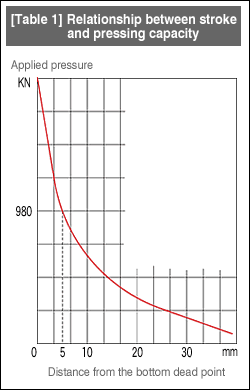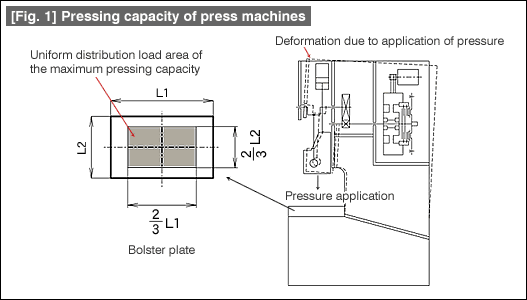In the crank press which is used most widely in press forming, there is the pressing capacity (capacity to apply pressure) which is an indicator of the capacity of the press machine.
Pressing capacity is the maximum pressure that the press machine can generate safely. As shown in Table
 |
While it is wrongly thought that the press machine is hard and does not get deformed even when the applied pressure is acting, even within the permissible range of the pressure applying capacity, the frame and the bolster plate of the press machine become elastically deformed as shown in Fig. 1. Even when there is deformation of the frame etc., safety is guaranteed if the load is less than the pressure applying capacity.

The pressure called pressing capacity assumes that uniformly distributed load is active on a predetermined region in the area of the bolster plate as shown in Fig. 1. Even within the permissible range of the pressing capacity it is not good to make a concentrated force act on a narrow region.
From the aspect of tool life of the die, if work is done at the maximum pressing capacity, the life of the die will become shorter due to the effects of deformations of the frame and the bolster plate of the press machine. When the tool life of the die is considered, it is necessary to carry out the work while having some leeway with respect to the pressing capacity. Generally, it is considered good for the life of the die to carry out work at pressures up to 60 to 70% of the pressing capacity.
Technology News
- Preparing Compound Die Structures
- Blanking Force
- Capacity of Press Machine
- Die Height
- Method of Using Die Sets
- Bending Stamping Die Structure
- Die Structure---Blanking&Drawing
- Die Structure' Change Depending on the Guides
- Accuracy Judgment of Press Dies
- Plate Constitution of Stamping Dies
- Method for Compound Die Structures Preparing
- Design of Banking Dies Shape
- Basic Structures for Stamping Dies
- Tool Life of Stamping Dies
- Progressive Stamping Explaination
- What is Metal Stamping Tools
- Stamping Die Standard Parts Industry in China
- Main Operation Performed in a Stamping Die
- Clearance in the Blanking Procedure
- Punch and Die Disign for Punching Small Diameter Holes




